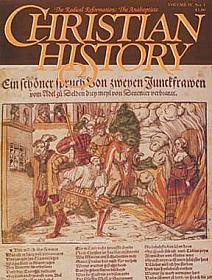Anabaptist Maeyken Wens Died a Cruel Death for Christ
MAEYKEN WENS was an Anabaptist of the branch which would later be known as Mennonites. Her husband was a stonemason and the pastor of a group of these Anabaptists. Wens had nine children, one of whom would witness her cruel death.
In the Spring of 1573, Roman Catholic authorities in Antwerp arrested Wens and some other women who had been worshipping with her. They subjected them to torture in an attempt to get them to renounce their beliefs, which differed from Catholic teaching on baptism and the Lord’s Supper, among other things. But none of the women recanted. On this day, 5 October 1573, authorities sentenced Wens to death along with her faithful friends whose names have been lost to history. All were condemned to have their tongues screwed tight so they could not speak to the bystanders about Christ or repentance.
Her captors did allow Wens to write letters. To her husband she wrote, “I should never have thought that parting should come so hard to me as it does,” and pleaded for his prayers that she would be able to let him go willingly, quoting Christ’s words that “He who does not forsake everything is not worthy of me.” In the same letter she noted, “Oh, how easy it is to be a Christian, so long as the flesh is not put to the trial, or nothing has to be relinquished; then it is an easy thing to be a Christian.”
After her sentence was passed, she wrote to Adriaen, her fifteen-year-old son, “My dear son, be not afraid of this suffering; it is nothing compared to that which shall endure forever. The Lord takes away all fear; I did not know what to do for joy, when I was sentenced. Hence cease not to fear God, because of this temporal death; I cannot fully thank my God for the great grace which He has shown me.”
Adriaen bravely went to the place of execution, but when his mother was brought out to the stake, he was so overcome by emotion he passed out. Regaining consciousness after the fire had died, he sifted the ashes for her tongue-screw, which he found and kept in her remembrance.
—Dan Graves
------------
A true story about Anabaptist beginnings is told in the docu-drama The Radicals. Watch at RedeemTV
(The Radicals can be purchased at Vision Video)
Read more about the Anabaptist experience in Christian History #5, Radical Reformation








